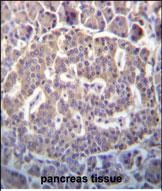SCYL1 Antibody (N-term)
Affinity Purified Rabbit Polyclonal Antibody (Pab)
- 产品详情
- 实验流程
- 背景知识
Application
| WB, IHC-P, E |
|---|---|
| Primary Accession | Q96KG9 |
| Other Accession | A6QLH6 |
| Reactivity | Human |
| Predicted | Bovine |
| Host | Rabbit |
| Clonality | Polyclonal |
| Isotype | Rabbit IgG |
| Calculated MW | 89631 Da |
| Antigen Region | 156-185 aa |
| Gene ID | 57410 |
|---|---|
| Other Names | N-terminal kinase-like protein, Coated vesicle-associated kinase of 90 kDa, SCY1-like protein 1, Telomerase regulation-associated protein, Telomerase transcriptional element-interacting factor, Teratoma-associated tyrosine kinase, SCYL1, CVAK90, GKLP, NTKL, TAPK, TEIF, TRAP |
| Target/Specificity | This SCYL1 antibody is generated from rabbits immunized with a KLH conjugated synthetic peptide between 156-185 amino acids from the N-terminal region of human SCYL1. |
| Dilution | WB~~1:1000 IHC-P~~1:100~500 E~~Use at an assay dependent concentration. |
| Format | Purified polyclonal antibody supplied in PBS with 0.09% (W/V) sodium azide. This antibody is purified through a protein A column, followed by peptide affinity purification. |
| Storage | Maintain refrigerated at 2-8°C for up to 2 weeks. For long term storage store at -20°C in small aliquots to prevent freeze-thaw cycles. |
| Precautions | SCYL1 Antibody (N-term) is for research use only and not for use in diagnostic or therapeutic procedures. |
| Name | SCYL1 |
|---|---|
| Synonyms | CVAK90, GKLP, NTKL, TAPK, TEIF, TRAP |
| Function | Regulates COPI-mediated retrograde protein traffic at the interface between the Golgi apparatus and the endoplasmic reticulum (PubMed:18556652). Involved in the maintenance of the Golgi apparatus morphology (PubMed:26581903). |
| Cellular Location | Cytoplasm, cytoskeleton, microtubule organizing center, centrosome. Endoplasmic reticulum-Golgi intermediate compartment Golgi apparatus, cis-Golgi network Note=Localized to the Endoplasmic reticulum-Golgi intermediate and cis- Golgi in an ARF1-independent manner [Isoform 2]: Cytoplasm. Note=Cytoplasmic throughout the cell cycle [Isoform 6]: Nucleus |
| Tissue Location | Ubiquitous.. |
For Research Use Only. Not For Use In Diagnostic Procedures.
Provided below are standard protocols that you may find useful for product applications.
BACKGROUND
SCYL1 forms multimers following transfection into COS-7 cells. SCYL1 forms a 300-kD trimer using crosslinking reagents. Biochemical analysis revealed no phosphorylation or autophosphorylation activity.The 707-amino acid SCYL1 variant, variant 2, localized to centrosomes during mitosis. During interphase, fluorescence-tagged variant 2 localized in the cytoplasm as well as centrosomes. However, at the beginning of mitosis, the fluorescence appeared as a pair of bright nuclear foci that followed centrosome localization throughout mitosis, while maintaining diffuse cytoplasmic labeling. Endogenous variant 2 in HeLa cells showed a similar staining pattern. Centrosomal localization was independent of microtubules.
REFERENCES
Tang, Z., et al., Biochem. Biophys. Res. Commun. 324(4):1324-1332 (2004).
Kato, M., et al., Genomics 79(6):760-767 (2002).
Liu, S.C., et al., Biochim. Biophys. Acta 1517(1):148-152 (2000).
van Asseldonk, M., et al., Genomics 66(1):35-42 (2000).
终于等到您。ABCEPTA(百远生物)抗体产品。
点击下方“我要评价 ”按钮提交您的反馈信息,您的反馈和评价是我们最宝贵的财富之一,
我们将在1-3个工作日内处理您的反馈信息。
如有疑问,联系:0512-88856768 tech-china@abcepta.com.























 癌症的基本特征包括细胞增殖、血管生成、迁移、凋亡逃避机制和细胞永生等。找到癌症发生过程中这些通路的关键标记物和对应的抗体用于检测至关重要。
癌症的基本特征包括细胞增殖、血管生成、迁移、凋亡逃避机制和细胞永生等。找到癌症发生过程中这些通路的关键标记物和对应的抗体用于检测至关重要。 为您推荐一个泛素化位点预测神器——泛素化分析工具,可以为您的蛋白的泛素化位点作出预测和评分。
为您推荐一个泛素化位点预测神器——泛素化分析工具,可以为您的蛋白的泛素化位点作出预测和评分。 细胞自噬受体图形绘图工具为你的蛋白的细胞受体结合位点作出预测和评分,识别结合到自噬通路中的蛋白是非常重要的,便于让我们理解自噬在正常生理、病理过程中的作用,如发育、细胞分化、神经退化性疾病、压力条件下、感染和癌症。
细胞自噬受体图形绘图工具为你的蛋白的细胞受体结合位点作出预测和评分,识别结合到自噬通路中的蛋白是非常重要的,便于让我们理解自噬在正常生理、病理过程中的作用,如发育、细胞分化、神经退化性疾病、压力条件下、感染和癌症。







